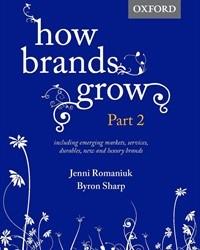





These are the thoughts of Prof Jenni Romaniuk when she addressed delegates at the launch of her second book, How Brands Grow 2 at the Wanderers Club in Johannesburg. The event was hosted by Spark Media. An international research professor and author from the Ehrenburg Bass Institute in Australia, this is Prof Romaniuk's second visit to South Africa.
How Brands Grow 2 follows on from her first book, How Brands Grow. She describes How Brands Grow 2 as a book about action, "The first book was about evidence. The second is about extending this evidence into action."

This is important because many of the principles of marketing that we have been taught are no longer valid or relevant, but we fall back on them she says. "There is no point in gaining new knowledge but still sticking to what we know. Then we will not reap any benefits. We need to follow the journey of evidence-based marketing."
Think about the objective of the brand and the medium you are designing for she says. For example there are so many different ways in which we watch television so design your branding to cut through all the different style of viewing. "Consumers do not get the brand because they have viewed it ten times in 30 seconds; they get it because it is presented in different execution styles."
For creativity to work it has to get through people's screening mechanism. But we ignore this she says, and instead we think creativity is king and we must sacrifice everything for the most creative idea. "No, this is not so. Emotional reaction does not have to come at the end of a message. The best advertising makes us feel, but it also puts something useful in our brains. This helps the brand when the person is in a buying situation."
For advertising to work people have to know who is advertising. "Branding lifts the quality of advertising and it is a fundamental hygiene factor. Advertising with no branding or very little is designed for the person playing full attention, which most people today are not giving your advertising."
Consumers also do not hate brands or advertising. She says research shows having your brand on a piece of content will not drive consumers away. "They know it is from you. The distinctive assets of your brand in an advertisement adds neurological richness to branding. It makes it easily recognisable as your brand so up the neurological richness of the brand by representing it in different ways, for example face, colour etc. (distinctive assets) and it allows you to compete with other creative elements. It gives the brand the opportunity to say hey I am over here."

Messaging that works considers the buyer and not the brand. It builds memory structures that are retrieval paths." Brands must attach themselves to a person's thoughts when they enter a category."
She says a buyer of shampoo is not thinking about the brand, but about themselves, for example my hair colour is fading, my hair is limp, etc. These are category entry points. "It is not about your brand but about your brand fitting into their lives. That's why when advertising talks about itself the viewer switches off. Much like a person at a party who only talks about himself."
Brands need to be relevant, which means making sure you have something that is buyable in that situation. "For example big packs of product at a good price might seem relevant to a poorer population. However in Vietnam, smaller packs are relevant because the people use bicycles for transport."
Also look at what is stopping people from buying your brand - sometimes it has nothing to do with the brand. "Sainsbury's salted their parking area when it was snowing in the UK making it easy for shoppers to park and this increased their sales. Be creative in your solution."
Be prominent, she says it is not enough to merely be there. "It is a cluttered and competitive environment and your brand has to overcome this. Leverage your distinct assets. Think how you can utilise these in the shopping environment."
Distinctive assets are the elements apart from the brand name that triggers the brand name for category buyers, for example logos, characters, shape, fonts, tag lines.
To get your brand on the paths to growth you need to act now she says. "Check your media plan is delivering maximum reach across all category buyers. Then check your touch points are easily identifiable as for your brand even in a light category and with brand buyers."
If you miss the opportunity it sets the brand backward or what she terms, the do or decay moment. "It creates doubt about the association you have built. Implement a long term distinctive assets management plan and check for speed bumps that slow down the path to purchase or divert buyers to competitors," she says.
"Marketing today is akin to baking. When you bake there are certain rules and laws and if you follow the recipe then your cake will be a success. If you do not, it will flop. Now is an exciting time to be in marketing, if you follow the rules and recipe."
